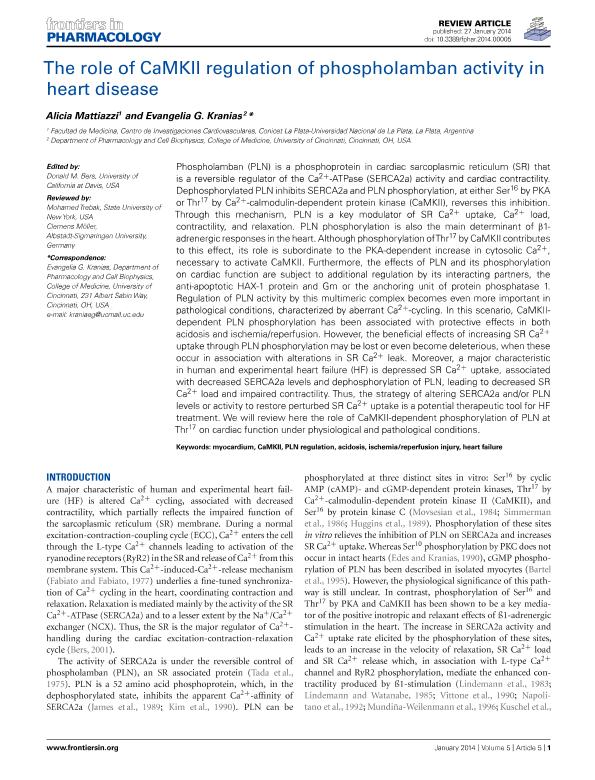Mostrar el registro sencillo del ítem
dc.contributor.author
Mattiazzi, Ramona Alicia

dc.contributor.author
Kranias, Evangelina G.
dc.date.available
2017-09-22T18:53:29Z
dc.date.issued
2014-01-27
dc.identifier.citation
Mattiazzi, Ramona Alicia; Kranias, Evangelina G.; The role of CaMKII regulation of phospholamban activity in heart disease; Frontiers; Frontiers in Pharmacology; 5; 5; 27-1-2014; 1-5
dc.identifier.issn
1663-9812
dc.identifier.uri
http://hdl.handle.net/11336/24977
dc.description.abstract
Phospholamban (PLN) is a phosphoprotein in cardiac sarcoplasmic reticulum (SR) that is a reversible regulator of the Ca2+-ATPase (SERCA2a) activity and cardiac contractility. Dephosphorylated PLN inhibits SERCA2a and PLN phosphorylation, at either Ser16 by PKA or Thr17 by Ca2+-calmodulin-dependent protein kinase (CaMKII), reverses this inhibition. Through this mechanism, PLN is a key modulator of SR Ca2+ uptake, Ca2+ load, contractility, and relaxation. PLN phosphorylation is also the main determinant of β1- adrenergic responses in the heart. Although phosphorylation ofThr17 by CaMKII contributes to this effect, its role is subordinate to the PKA-dependent increase in cytosolic Ca2+, necessary to activate CaMKII. Furthermore, the effects of PLN and its phosphorylation on cardiac function are subject to additional regulation by its interacting partners, the anti-apoptotic HAX-1 protein and Gm or the anchoring unit of protein phosphatase 1. Regulation of PLN activity by this multimeric complex becomes even more important in pathological conditions, characterized by aberrant Ca2+-cycling. In this scenario, CaMKIIdependent PLN phosphorylation has been associated with protective effects in both acidosis and ischemia/reperfusion. However, the beneficial effects of increasing SR Ca2+ uptake through PLN phosphorylation may be lost or even become deleterious, when these occur in association with alterations in SR Ca2+ leak. Moreover, a major characteristic in human and experimental heart failure (HF) is depressed SR Ca2+ uptake, associated with decreased SERCA2a levels and dephosphorylation of PLN, leading to decreased SR Ca2+ load and impaired contractility. Thus, the strategy of altering SERCA2a and/or PLN levels or activity to restore perturbed SR Ca2+ uptake is a potential therapeutic tool for HF treatment. We will review here the role of CaMKII-dependent phosphorylation of PLN at Thr17 on cardiac function under physiological and pathological conditions.
dc.format
application/pdf
dc.language.iso
eng
dc.publisher
Frontiers
dc.rights
info:eu-repo/semantics/openAccess
dc.rights.uri
https://creativecommons.org/licenses/by-nc-sa/2.5/ar/
dc.subject
Myocardium
dc.subject
Camkii
dc.subject
Pln Regulation
dc.subject
Acidosis
dc.subject
Ischemia/Reperfusion Injury
dc.subject
Heart Failure
dc.subject.classification
Bioquímica y Biología Molecular

dc.subject.classification
Ciencias Biológicas

dc.subject.classification
CIENCIAS NATURALES Y EXACTAS

dc.title
The role of CaMKII regulation of phospholamban activity in heart disease
dc.type
info:eu-repo/semantics/article
dc.type
info:ar-repo/semantics/artículo
dc.type
info:eu-repo/semantics/publishedVersion
dc.date.updated
2017-09-18T14:29:33Z
dc.journal.volume
5
dc.journal.number
5
dc.journal.pagination
1-5
dc.journal.pais
Suiza

dc.journal.ciudad
Lausanne
dc.description.fil
Fil: Mattiazzi, Ramona Alicia. Consejo Nacional de Investigaciones Científicas y Técnicas. Centro Científico Tecnológico Conicet - la Plata. Centro de Investigaciones Cardiovasculares "Dr. Horacio Eugenio Cingolani". Universidad Nacional de la Plata. Facultad de Ciencias Médicas. Centro de Investigaciones Cardiovasculares "Dr. Horacio Eugenio Cingolani"; Argentina
dc.description.fil
Fil: Kranias, Evangelina G.. University of Cincinnati; Estados Unidos
dc.journal.title
Frontiers in Pharmacology
dc.relation.alternativeid
info:eu-repo/semantics/altIdentifier/doi/http://dx.doi.org/10.3389/fphar.2014.00005
dc.relation.alternativeid
info:eu-repo/semantics/altIdentifier/url/http://journal.frontiersin.org/article/10.3389/fphar.2014.00005/full
Archivos asociados
